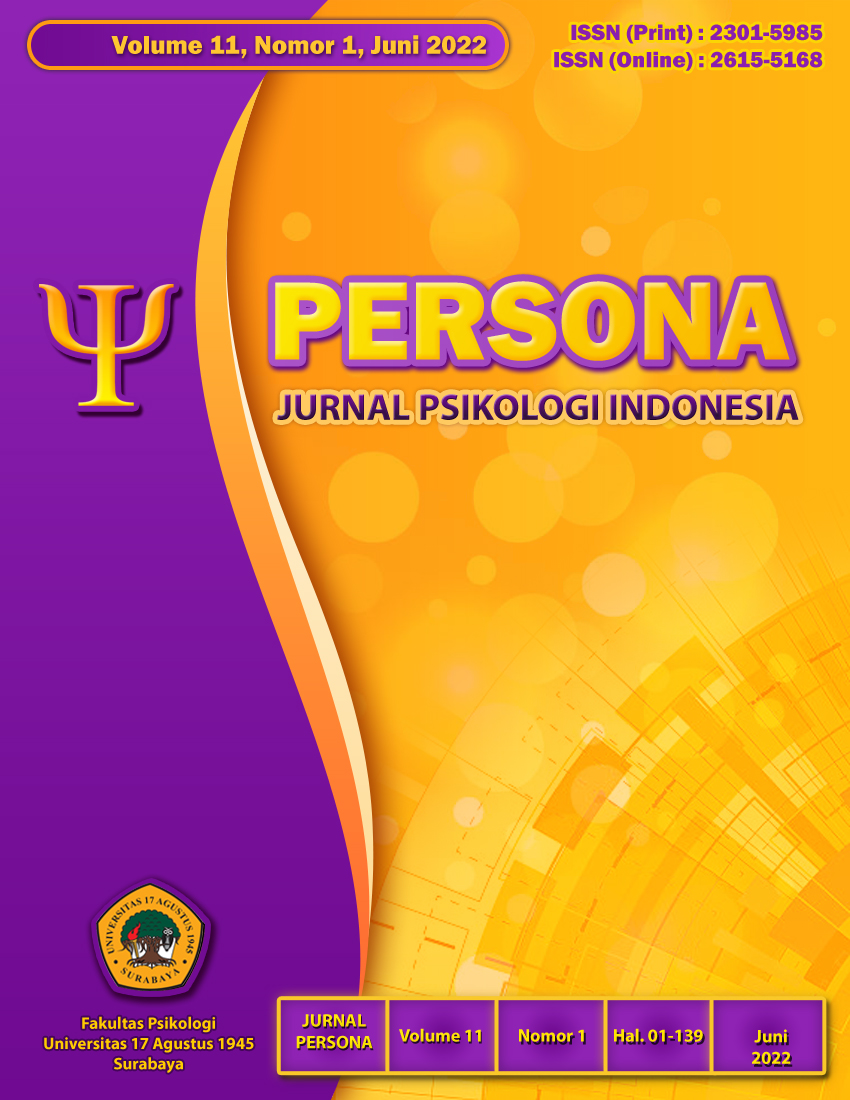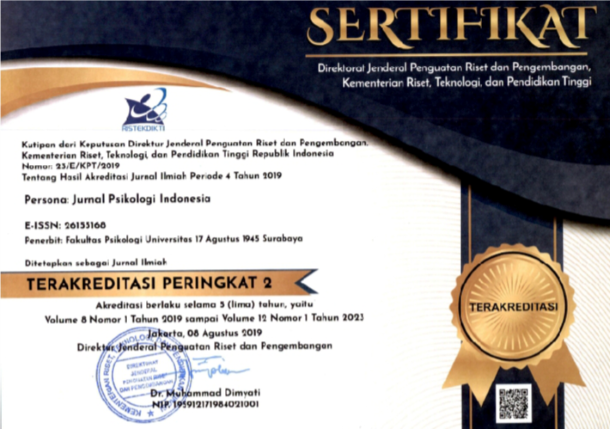Efek mediasi ketakutan menjadi lajang dalam hubungan antara stereotip negatif dan kesejahteraan psikologi perempuan lajang
Abstract
Abstract
The number of single women in Indonesia is increasing, but single women in Indonesia are also vulnerable to negative stereotypes. Unpleasant experiences experienced by single women can have a negative impact. This study examines the association between negative stereotypes and psychological well-being and the mediating effect of fear of being single. The study participants were 196 single women aged 25 – 55 years, had completed their high school, and staying in Indonesia. Participants reported their experiences as single such as psychological well-being, happiness, negative stereotypes, fear of being single, dating experience, and desire to marry. Those experiences were measured by Ryff’s psychological well-being scale (α=0,80), Pignotti’s & Abell’s negative stereotyping of single persons scale(α=0,754-0,88) , Spielman’s fear of being scale (α=0,829), conscientiousness of BFI personality scale (α=0,821) and open questionnaire. Linear regression analysis was performed to test the relationship between variables. The results show that negative stereotypes reduce the psychological well-being of single women in Indonesia, and the fear of being single mediates the association between the two variables. Findings of this study indicate the need for social change to replace unfavourable labels received by single women in Indonesia and provide information for improving the psychological well-being of single Indonesian women.
Keywords: fear of being single; negative stereotypes; psychological well-being; single women
Abstrak
Jumlah perempuan lajang di Indonesia semakin meningkat, namun perempuan lajang di Indonesia juga rentan mengalami stereotip negatif. Pengalaman tidak menyenangkan yang dialami perempuan lajang ini dapat membawa dampak negatif. Penelitian ini mengkaji asosiasi antara stereotip negatif dan kesejahteraan psikologis serta efek mediasi dari ketakutan menjadi lajang. Partisipan penelitian adalah 196 perempuan lajang berusia 25 – 55 tahun, berpendidikan minimal setara dengan SMA dan berdomisili di Indonesia yang melaporkan pengalaman sebagai lajang seperti kesejahteraan psikologis, kebahagiaan, stereotip negatif, ketakutan menjadi lajang, pengalaman berpacaran, dan keinginan untuk menikah. Pengalaman partisipan diukur dengan skala kesejahteraan psikologis Ryff (α=0,80), skala stereotip negatif individu lajang Pignotti dan Abell (α=0,754-0,88), skala fear of being single Spielman (α=0,829), skala BFI kepribadian conscientiousness (α=0,821). Analisis regresi linear dilakukan untuk menguji hubungan antar variabel. Hasil menunjukkan stereotip negatif menurunkan kesejahteraan psikologis perempuan lajang di Indonesia dan ketakutan menjadi lajang memediasi asosiasi kedua variabel tersebut. Temuan penelitian ini menunjukkan perlunya perubahan sosial untuk mengganti label buruk yang diterima perempuan lajang di Indonesia serta menjadi informasi bagi peningkatan kesejahteraan psikologis perempuan lajang Indonesia.
Kata kunci: ketakutan menjadi lajang; kesejahteraan psikologis; perempuan lajang; stereotip negatif
Downloads
References
Abbott, R.A., Ploubidis, G.B., Huppert, F.A., Kuh, D., Wadsworth, M. E. J., & Croudace, T. J. (2006). Psychometric evaluation and predictive validity of Ryff's psychological well-being items in a UK birth cohort sample of women. Health and Quality of Life Outcomes, 4(76). https://doi.org/10.1186/1477-7525-4-7
Alwi, A., & Lourdunathan, P. (2020). Challenges and well-being of single women living in Malaysia. The Journal of Behavioral Science, 15(1), 1–18.
Apostolou, M., O, J., & Esposito, G. (2020). Singles’ reasons for being single: Empirical evidence from an evolutionary perspective. Frontiers in Psychology, 11, Article 746. https://doi.org/10.3389/fpsyg.2020.00746
Bellani, D., Esping-Andersen, G., & Nedoluzhko, L. (2017). Never partnered: A multilevel analysis of lifelong singlehood. Demographic Research, 37(1). https://doi.org/10.4054/DemRes.2017.37.4
Beri, N., & Beri, A. (2013). Perception of single women towards marriage, career and education. European Academic Research, 1(6), 855–869.
BPS-RI, SUSENAS. (2009 – 2021). Persentase rumah tangga menurut daerah tempat tinggal, kelompok umur, jenis kelamin, kepala rumah tangga, dan status perkawinan.
Brauer, K., & Proyer, R. T. (2020). Gelotophobia in romantic life: replicating associations with attachment styles and their mediating role for relationship status. Journal of Social and Personal Relationships, 37(10–11), 2890–2897. https://doi.org/10.1177/0265407520941607
Chin, B., Murphy, M. L. M., Janicki-Deverts, D., Cohen, S. (2017). Marital status as a predictor of diurnal salivary cortisol levels and slopes in a community sample of healthy adults. Psychoneuroendocrinology, 78, 68-75. https://doi.org/10.1016/j.psyneuen.2017.01.016
DePaulo, B. M., & Morris, W. L. (2005). Singles in society and in science. Psychological Inquiry, 16(2-3), 57–83.
Gaetano, A. M. (2009). Single women in urban China and the “unmarried crisis”: Gender resilience and gender transformation [Working paper in Contemporary Asian Studies; No. 31]. Centre for East and South-East Asian Studies, Lund University, Sweden.
Girme, Y.U., Overall, N.C., Faingataa, S. & Sibley, C.G. (2015). Happily single: The link between relationship status and well-being depends on avoidance and approach social goals. Social Psychology and Personality Science, 7(2), 122-130. https://doi.org/10.1177/1948550615599828
Greitemeyer, T. (2009). Stereotypes of singles: Are singles what we think? European Journal of Social Psychology, 39(3), 368-383. https://doi.org/10.1002/ejsp.542
Hertel, J., Schütz, A., DePaulo, B. M., Morris, W. L., & Stucke, T. S. (2007). She’s single, so what? How are singles perceived compared with people who are married? Journal of Family Research, 19(2), 139–158. https://doi.org/10.20377/JFR-301
Hickin, N., Käll, A., Shafran, R., Sutcliffe, S., Manzotti, G., & Langan, D. (2021). The effectiveness of psychological interventions for loneliness: A systematic review and meta-analysis. Clinical Psychology Review, 88, Article 102066. https://doi.org/10.1016/j.cpr.2021.102066
Himawan, K. K., Bambling, M., & Edirippulige, S. (2018). What does it mean to be single in Indonesia? Religiosity, social stigma, and marital status among never-married Indonesian adults. SAGE Open, 8(3). https://doi.org/10.1177/2158244018803132
Himawan, K. K., Underwood, M., Bambling, M., & Edirippulige, S. (2021). Being single when marriage is the norm: Internet use and the well-being of never-married adults in Indonesia. Current Psychology. https://doi.org/10.1007/s12144-021-01367-6
Hsu, T. -L., & Barret, A. E. (2020). The association between marital status psychological well-being: Variation across negative and positive dimensions. Journal of Family Issues, 41(11), 2179-2202. https://doi.org/10.1177/0192513X20910184
Ibrahim, R., & Hassan, Z. (2009). Understanding singlehood from the experiences of never-married malay muslim women in Malaysia: Some preliminary findings. European Journal of Social Sciences, 8(3), 395–405.
Ismail, Z., & Desmukh, S. (2012). Religiosity and psychological well-Being. International Journal of Business and Social Science, 3(11), 20–28.
Jackson, J. B. (2018). The ambiguous loss of singlehood: Conceptualizing and treating singlehood ambiguous loss among never-married adults. Contemporary Family Therapy, 40, 210–222. https://doi.org/10.1007/s10591-018-9455-0
John, O. P., & Srivastava, S. (1999). The big five trait taxonomy: History, measurement, and theoretical perspectives. In L. A. Pervin & O. P. John (Eds.), Handbook of personality: Theory and research (pp. 102–138). Guilford Press.
Kim, H. K. & Kenry, P. C. (2002). The relationship between marriage and psychological well being: A longitudinal analysis. Journal of Family Issues, 23(8), 885 – 991.
Kislev, E. (2020). How do relationship desire and sociability relate to each other among singles? Longitudinal analysis of the Pairfam survey. Journal of Social and Personal Relationships, 37(8–9), 2634–2650. https://doi.org/10.1177/0265407520933000
Kokko, K., Tolvanen, A., & Pulkkinen, L. (2013). Associations between personality traits and psychological well-being across time in middle adulthood. Journal of Research in Personality, 47(6), 748–756. https://doi.org/10.1016/J.JRP.2013.07.002
Kowarik, A. &, Templ, M. (2016). Imputation with the R Package VIM. Journal of Statistical Software, 74(7), 1-16. https://10.18637/jss.v074.i07
Lahad, K. (2017). A table for one: A critical reading of singlehood, gender and time (1st ed.) Manchester University Press. https://doi.org/10.2307/j.ctt1wn0s66
Licy, A. D. (2015). The support system of single women. International Journal of Applied Research, 1(12), 882–890.
Marks, N. F. (1996). Flying solo at midlife: Gender, marital status, and psychological well being. Journal of Marriage and The Family, 58(4), 917-932
Masi, C. M., Chen, H. Y., Hawkley, L. C., Cacioppo, J. T. (2011). A meta-analysis of interventions to reduce loneliness. Personality and Social Psychology Review, 15(3), 219-266. https://doi.org/10.1177/1088868310377394
Nanik, Mareyke, M. W. T., & Hendriani, W. (2018). “She is a Spinster”: A descriptive study on perception toward single women. International Journal of Engineering & Technology, 7(2.29), 667-674. https://doi.org/10.14419/IJET.V7I2.29.13995
Pignotti, M. & Abell, N. (2009). The negative stereotyping of single persons scale. Research on Social Work Practice, 19(5), 639-652. https://doi.org/10.1177/1049731508329402
R Core Team (2020). R: A language and environment for statistical computing. R Foundation for Statistical Computing, Vienna, Austria. https://www.R-project.org/
Riffenburgh, R. H. (2012). Planning studies: From design to publication. In R. H. Riffenburgh (Ed.), Statistics in medicine (3rd ed., pp. 1-26). Academic Press. https://doi.org/10.1016/B978-0-12-384864-2.00001-9
Ryan, R. M., & Deci, E. L. (2001). On happiness and human potentials: A review of research on hedonic and eudaimonic well-being. Annual Reviews Psychology, 52, 141–166. https://doi.org/10.1146/annurev.psych.52.1.141
Ryff, C. D. (2013). Psychological well-being revisited: Advances in the science and practice of eudaimonia. Psychotherapy and Psychosomatics, 83(1), 10–28. https://doi.org/10.1159/000353263
Sarkisian, N., & Gerstel, N. (2016). Does singlehood isolate or integrate? Examining the link between marital status and ties to kin, friends, and neighbors. Journal of Social and Personal Relationships, 33(3), 361–384. https://doi.org/10.1177/0265407515597564
Shahrak, S. P., Brand, S. & Taghizadeh, Z. (2021). Living with singleness: Needs and concerns of never-married women over 35. BMC Psychology, 9, Article 129. https://doi.org/10.1186/s40359-021-00635-1
Setyonaluri, D., Maghfirah, A., & Aryaputra, C. (2020). Norms in transition? The Relationship between education and singlehood. Jurnal Studi Pemuda, 9(2), 136-148. https://doi.org/10.22146/STUDIPEMUDAUGM.57995
Situmorang, A. (2007). Staying single in a married world: Never-married women in Yogyakarta and Medan. Asian Population Studies, 3(3), 287–304. https://doi.org/10.1080/17441730701746433
Slonim, G., Gur-Yaish, N., & Katz, R. (2015). By choice or by circumstance?: Stereotypes of and feelings about single people. Studia Psychologica, 57(1), 35-47. https://doi.org/10.21909/SP.2015.01.672
Spielmann, S. S., MacDonald, G., Maxwell, J. A., Joel, S., Peragine, D., Muise, A., & Impett, E. A. (2013). Settling for less out of fear of being single. Journal of Personality and Social Psychology, 105(6), 1049–1107. https://doi.org/10.1037/a0034628
Spielmann, S. S., Maxwell, J. A., MacDonald, G., Peragine, D., & Impett, E. A. (2020). The predictive effects of fear of being single on physical attractiveness and less selective partner selection strategies. Journal of Social and Personal Relationships, 37(1), 100–123. https://doi.org/10.1177/0265407519856701
Spielmann, S. S. & Cantarella, I. A. (2020). Fear of being single priming predicts maladaptive relationship pursuits. Personal Relationship, 27(4), 801– 819. https://doi.org/10.1111/pere.12348
Tanasya, J., Nanik, N., & Yuwanto, L. (2015). Hubungan religiusitas dan persepsi status lajang berkarir dengan pschological well-being pada perempuan lajang berkarir [The relation between religiousness and perception on the status of single with career with psychological well-being on single career women]. In embracing a new way of life: Promoting positive Psychology for better a mental health. Seminar Nasional Positive Psychology 2015: Embracing a New Way of Life: Promoting Positive Psychology for a Better Mental Health, 440–445.
Wang, H., & Abbott, D. A. (2013). Waiting for Mr. Right: The meaning of being a single educated Chinese female over 30 in Beijing and Guangzhou. Women’s Studies International Forum, 40, 222–229. https://doi.org/10.1016/J.WSIF.2013.08.004
Wickham, H. (2016). ggplot2: Elegant graphics for data analysis. Springer-Verlag. https://ggplot2.tidyverse.org
Wickham, H., François, R., Henry, L., & Müller, K. (2022). dplyr: A grammar of data manipulation. R package version 1.0.8. https://CRAN.R-project.org/package=dplyr
Winterstein, T. B., & Rimon, C. M. (2014). The experience of being an old never-married single: A life course perspective. International Journal of Aging and Human Development, 78(4), 397–401. https://doi.org/10.2190/AG.78.4.D
Copyright (c) 2022 Nanik Nanik, Edwin Adrianta Surijah, Lina Natalya, Mery Chrisyanti

This work is licensed under a Creative Commons Attribution-ShareAlike 4.0 International License.
The author who will publish the manuscript at Persona: Jurnal Psikologi Indonesia, agree to the following terms:
1. Authors retain copyright and grant the journal right of first publication with the work simultaneously licensed under a Creative Commons Attribution ShareAlike License that allows others to share the work with an acknowledgment of the work's authorship and initial publication in this journal.
2. Authors are able to enter into separate, additional contractual arrangements for the non-exclusive distribution of the journal's published version of the work (e.g., post it to an institutional repository or publish it in a book), with an acknowledgment of its initial publication in this journal.
3. Authors are permitted and encouraged to post their work online (e.g., in institutional repositories, pre-prints sites or on their website) prior to and during the submission process, as it can lead to productive exchanges, as well as earlier and greater dissemination of published work








